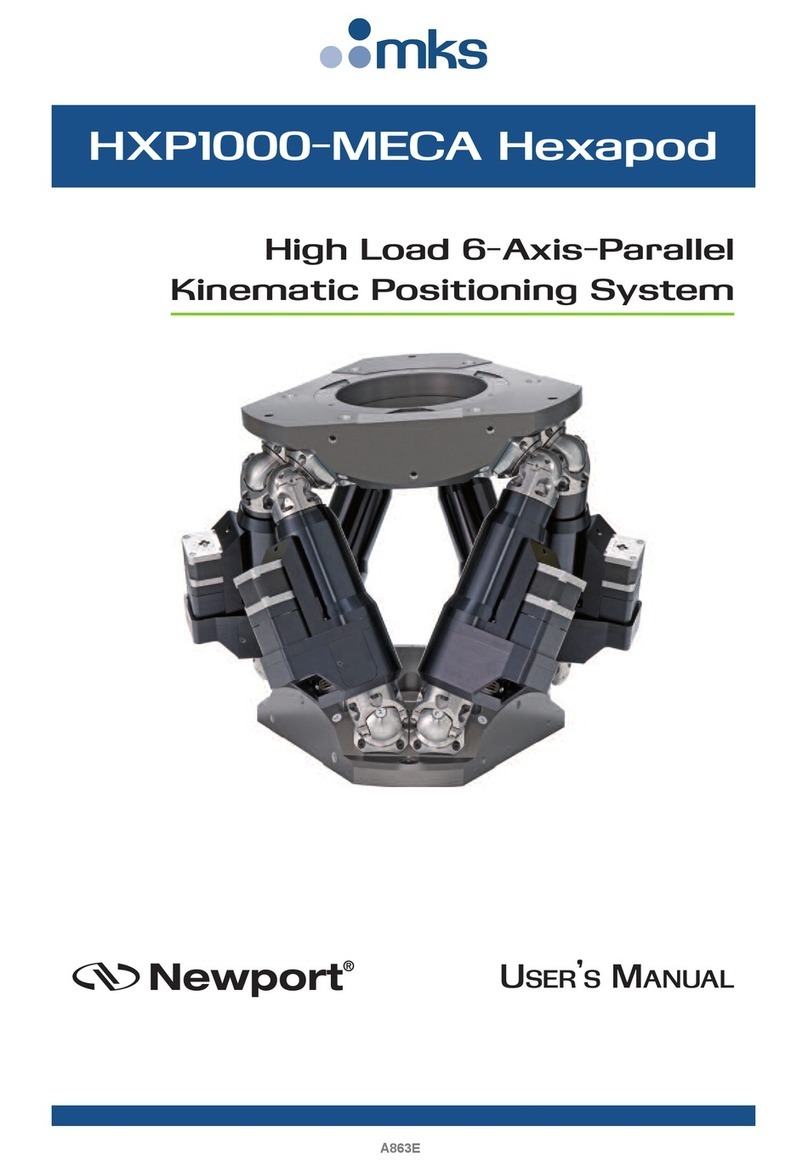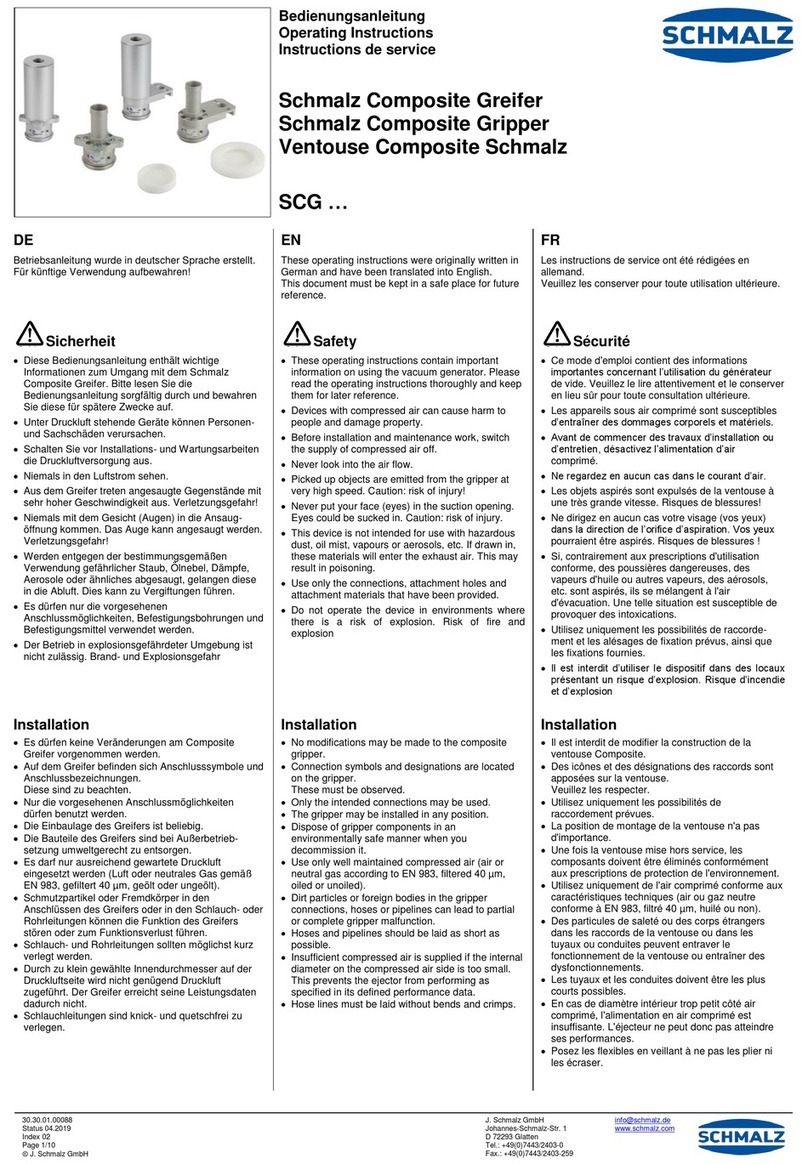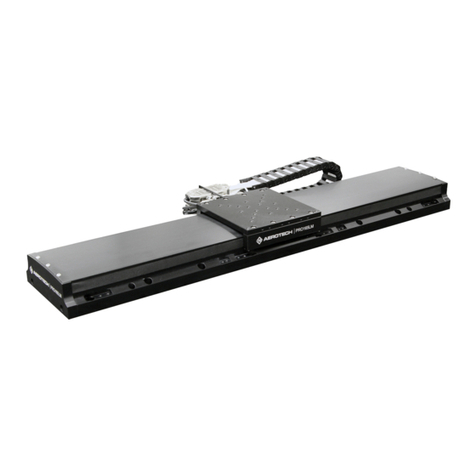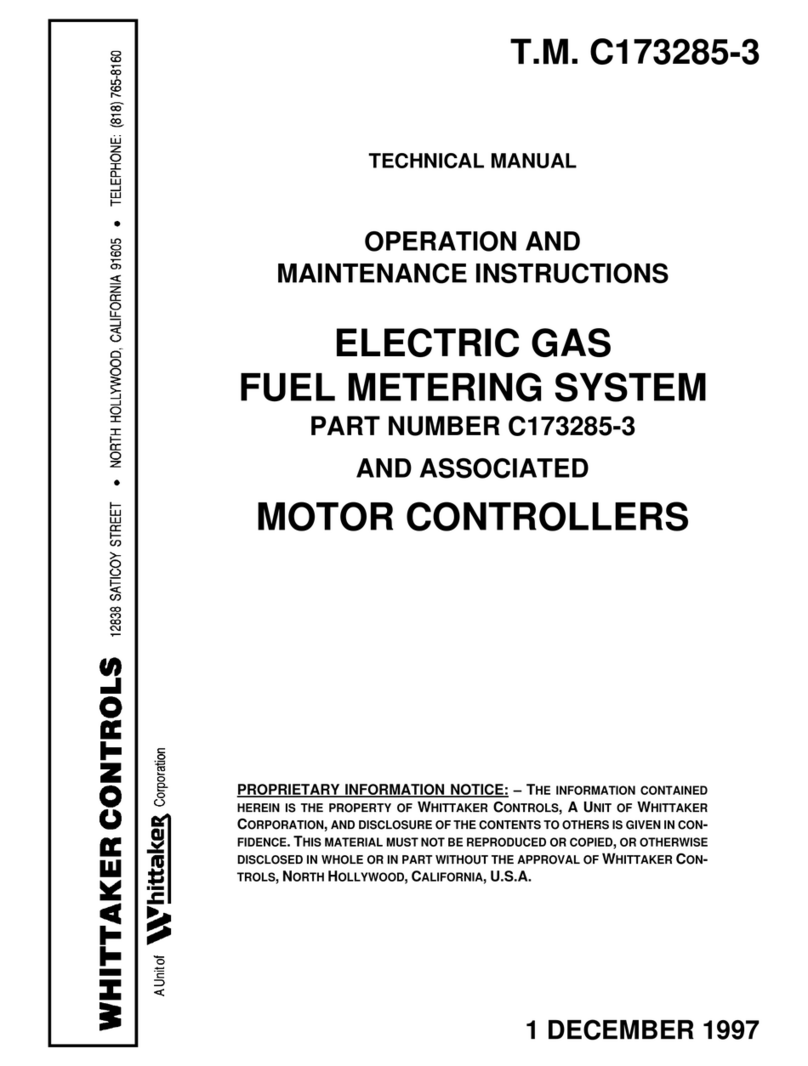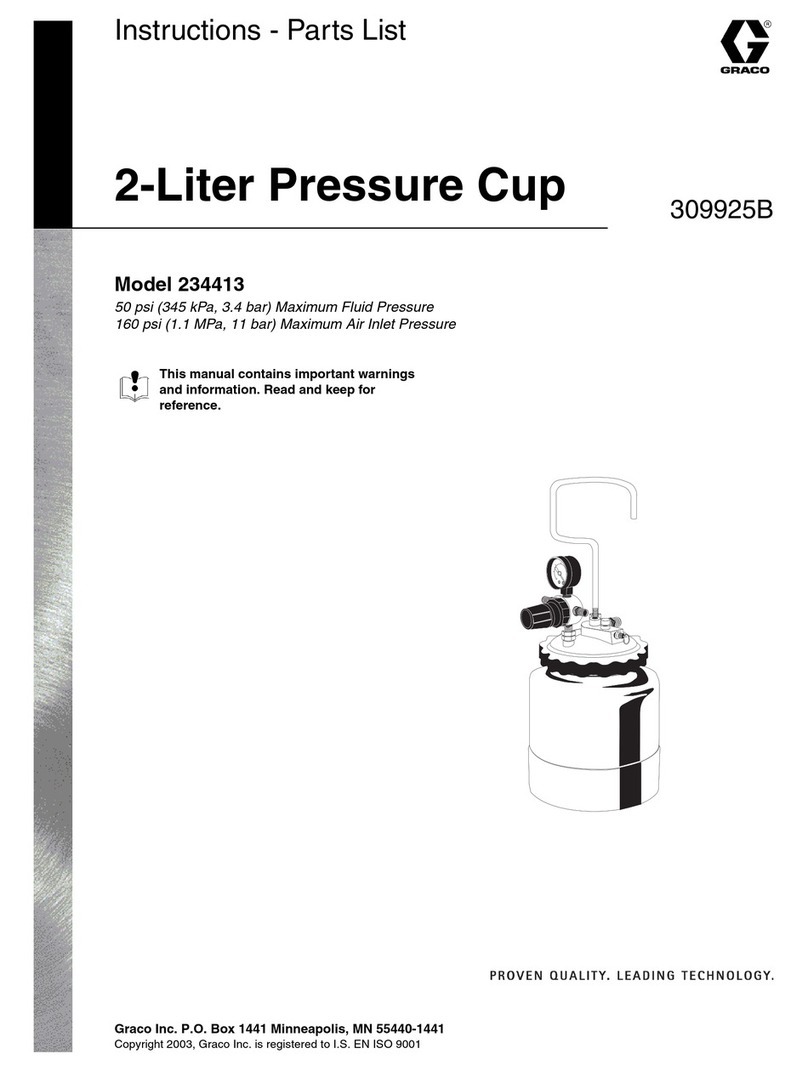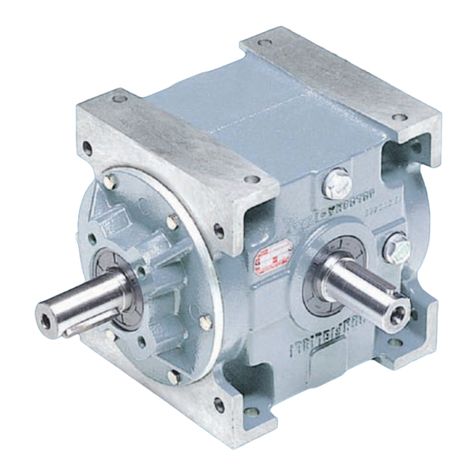Tuchel Tuchel-Trac Trio User manual

Operating manual
This operating manual is only valid in combination with the corresponding operating manual of
the combustion engine (diesel = Kubota)
The supplied delivery inspection form is to be filled out completely and returned to the
manufacturer.

Table of contents
2
Table of contents
Table of contents .............................................................................................................. 2
Foreword............................................................................................................................ 5
1General information about this operating manual................................................... 6
A word about this operating manual...................................................................................................... 6
Declaration of conformity........................................................................................................................ 7
2Safety........................................................................................................................... 9
General safety information ..................................................................................................................... 9
Intended use ............................................................................................................................................. 9
Safety instructions in the operating manual ....................................................................................... 10
Safety stickers on the machine ............................................................................................................ 11
Safety regulations .................................................................................................................................. 13
Safety installations ................................................................................................................................ 13
Clothing................................................................................................................................................... 13
Modifications to the machine ............................................................................................................... 14
Before leaving the machine .................................................................................................................. 14
Climbing on and off ............................................................................................................................... 14
Protecting against injuries.................................................................................................................... 14
Working with high temperatures .......................................................................................................... 15
Fire prevention and fire-fighting........................................................................................................... 15
Accessory equipment............................................................................................................................ 16
Battery ..................................................................................................................................................... 16
Before starting the engine..................................................................................................................... 16
Operating the machine .......................................................................................................................... 17
Transporting ........................................................................................................................................... 19
Safety measures during maintenance ................................................................................................. 20
Before performing maintenance work ................................................................................................. 20
During the maintenance ........................................................................................................................ 21
3Technical data........................................................................................................... 23
Dimensions............................................................................................................................................. 23
Work values ............................................................................................................................................ 23
Engine ..................................................................................................................................................... 24
Working hydraulics................................................................................................................................ 24
Additional equipment (option).............................................................................................................. 24
Noise emission....................................................................................................................................... 24
4Description / overview.............................................................................................. 25
General view ........................................................................................................................................... 26
Driver's position ..................................................................................................................................... 27
Control lever............................................................................................................................................. 27
Display panel............................................................................................................................................ 27
Hydraulic connections........................................................................................................................... 30
Quick-change unit.................................................................................................................................. 30
Accessories ............................................................................................................................................ 30

Table of contents
3
Type plate ................................................................................................................................................31
Identification marking locations............................................................................................................32
5Operation ...................................................................................................................33
Foot contact switch ................................................................................................................................33
Lift / lower control lever .............................................................................................................................33
Control lever L2 (option) ...........................................................................................................................34
Control lever L3.........................................................................................................................................34
Driving speed lever ...................................................................................................................................35
Control valve for pull-away / braking speed..............................................................................................35
Hand throttle lever.....................................................................................................................................35
6Operation ...................................................................................................................36
Placing into operation ............................................................................................................................36
Break-in time.............................................................................................................................................36
Checks before placing into operation .......................................................................................................37
Settings before starting .........................................................................................................................38
Adjusting the driver's seat.........................................................................................................................38
Starting the engine .................................................................................................................................39
Starting conditions ....................................................................................................................................39
Starting procedure ....................................................................................................................................39
Driving......................................................................................................................................................40
Safety regulations when driving................................................................................................................40
Driving forwards ........................................................................................................................................41
Braking......................................................................................................................................................41
Driving in reverse ......................................................................................................................................42
Steering and turning .................................................................................................................................42
Turning off the engine............................................................................................................................43
Working with accessory equipment .....................................................................................................44
Safety regulations when working with accessory equipment ...................................................................44
Installing the accessory equipment...........................................................................................................44
Removing the accessory equipment.........................................................................................................46
Placing out of operation.........................................................................................................................47
Turning off of the machine safely..............................................................................................................47
Storing the machine over longer periods of time ......................................................................................48
7Maintenance ..............................................................................................................49
Safeguards ..............................................................................................................................................49
Safety-relevant parts.................................................................................................................................49
General information on maintenance ...................................................................................................50
Battery.......................................................................................................................................................50
Engine.......................................................................................................................................................50
V-belt.........................................................................................................................................................50
Engine compartment.................................................................................................................................51
Lubricants and operating materials......................................................................................................51
Wearing parts / replacement parts........................................................................................................52
Maintenance / service intervals ................................................................................................................53
Maintenance overview............................................................................................................................54
10-hour maintenance / daily ..................................................................................................................58

Table of contents
4
Cleaning the machine .............................................................................................................................. 58
Tyres ........................................................................................................................................................ 59
50-hour maintenance / weekly .............................................................................................................. 60
Wheel nuts ............................................................................................................................................... 60
Lubricating points ..................................................................................................................................... 60
Checking the hydraulic oil fill level ........................................................................................................... 61
250-hour maintenance ........................................................................................................................... 62
Changing the hydraulic filter .................................................................................................................... 62
1000-hour maintenance / yearly ........................................................................................................... 63
Changing the hydraulic oil........................................................................................................................ 63
Maintenance as needed......................................................................................................................... 64
Changing the fuse .................................................................................................................................... 64
Service .................................................................................................................................................... 65
8Troubleshooting ....................................................................................................... 69
Engine ..................................................................................................................................................... 69
Brake ....................................................................................................................................................... 69
Traction drive ......................................................................................................................................... 70
Working hydraulics................................................................................................................................ 71
9Index .......................................................................................................................... 72

Foreword
5
Foreword
Dear Customer,
The Tuchel-Trac® product you have purchased has been
manufactured to the highest quality standards. In order to
eliminate any possibility of damage to persons or property, you
must read and observe the respective safety and warning
instructions in this manual and on the machine before using or
servicing the machine.
Before placing the machine into operation, all machine operators
must make themselves familiar with the handling of this machine
using this operating manual. The safety regulations are to be
strictly adhered to. Adherence to the valid safety regulations for
your country is also obligatory.

General information about this operating manual
6
1 General information about this
operating manual
A word about this operating manual
To maintain the safety and utilisability of the machine, a
professional operation as well as conscientious care and
maintenance are necessary. When you use the machine for its
intended purpose, the operating manual at hand will help you to
avoid damages to persons and property. The manual takes the
necessary legal conditions and guidelines into account and
contains important information.
The operating manual is part of the Tuchel-Trac® and should be
kept with the machine so that it is readily available at any time. If
the operating manual becomes soiled or gets lost, a new
replacement manual can be requested from Tuchel
Maschinenbau GmbH at any time. If the machine is sold, the
operating manual must be transferred to the new owner.
The owner of the machine bears the responsibility for the
following points:
•Every operator must be of at least legal minimum age and
physically as well as mentally fit to reliably fulfil the tasks
assigned to them.
•Every person who operates or services the machine must
have read and understood the operating manual beforehand.
•The machine may only be used for its intended purpose in
accordance with regulations.
•The machine may not be improperly modified or altered.
The declaration of conformity of the Tuchel Maschinenbau GmbH
expires if the owner allows safety-relevant modifications to be
performed on the machine. The party performing the
modifications must issue a new certificate. If you have questions
concerning this, please contact Tuchel directly.

General information about this operating manual
7
Declaration of conformity
The Tuchel-Trac® satisfies the "essential health and safety
requirements" of the machinery directive 2006/42/EC and is
authorised to carry the CE mark.
Furthermore, the harmonised European Norms DIN EN 12100,
DIN EN 982, DIN EN 1553 and BGV D 29 were used for the
development of the machine. These are documented in the EU
declaration of conformity.
Please see the back side of this operating manual for the
manufacturer address.
NOTE!
The declaration of conformity is depicted on the
following page.

General information about this operating manual
8
EG-Konformitätserklärung
im Sinne der EG-Richtlinie für Maschinen 2006/42/EG
Der Hersteller:
Tuchel Maschinenbau GmbH
Holsterfeld 15
D-48499 Salzbergen
erklärt hiermit, dass die nachstehend beschriebene Maschine:
Fabrikat: Tuchel-Trac Trio
Typ: 1601
Maschinennummer: .......................................
übereinstimmt mit den Bestimmungen folgender EG-Richtlinien:
•Maschinen-Richtlinie 2006/42/EG
•EMV-Richtlinie 2004/108/EG (Elektromagnetische Verträglichkeit)
Angewendete Normen und technische Spezifikationen:
•DIN EN ISO 12100-1:2003
•DIN EN ISO 12100-2:2003
•DIN EN 13857:2008
•DIN EN 349:1993
•DIN EN 982:1996
•DIN EN 1553:1999
•DIN EN 703:2005
Salzbergen, den September
2013
Dieter Beckmann
Geschäftsführer

Safety
9
2 Safety
General safety information
Most accidents are caused by the disregard of the essential
safety regulations. In order to prevent accidents and thus
eliminate any possibility of damage to persons or property, you
must have read and understood the respective safety and
warning instructions in this manual and in the manual of the
accessory equipment before performing any work.
Intended use
The machine is designed to be used solely for the purpose
defined in Chapter "Description / overview" (page 25) and the
approved components.
Any other use does not comply with the regulations/requirements
or intended use. The manufacturer cannot assume liability for any
damages resulting from an unintended use. The user/ owner
alone bears the risk for this.
Follow the corresponding safety instructions and working steps
from this operating manual and the manual of the accessory
equipment. These also pertain to the intended use.
Operating the machine on public roads is not allowed.
If necessary, a certificate of exemption must be applied for
according to §70 of the StVZO (Road Traffic Licensing
Regulations).

Safety
10
Safety instructions in the operating manual
In the operating manual at hand, the following signal words and
signs are used to make the safety instructions recognisable as
such at a glance:
This is the hazard warning. It warns you about the risk
of injury.
•Comply with all activities labelled with the hazard
warning in order to prevent injuries or death.
DANGER! – Danger of death
Identifies risks, which can result in severe injuries to
health or lead to death if the respective danger warning
was not observed or was not observed sufficiently.
WARNING! – Bodily injury
Identifies risks, which can cause physical injury if the
respective warning was not observed or was not
observed sufficiently.
CAUTION! – Light injuries
Identifies risks that can cause light bodily injury.
This is the caution warning. It warns you about the risk
of property damage. It differs from the hazard warning
in order to distinguish between property damage and
bodily injury.
•Comply with all activities labelled with the caution
warning in order to prevent property damage and
damage caused to the environment.
ATTENTION! – Property damage
Identifies solely the risk of possible property damage
and damage caused to the environment.
NOTE!
Identifies application tips and useful information.

Safety
11
Safety stickers on the machine
Information and symbols directly attached to the machine such as
safety labels must be observed without fail. They may not be
removed and are to be kept in a completely legible condition.
Read and observe the operating manual and safety instructions
before placing into operation.
Read and observe the operating manual and safety instructions
before performing any maintenance work.
Do not stay in the area of a raised and unsecured load.
The transporting of passengers is not permitted.
Caution with escaping high pressure fluid. Observe the safety
instructions in the operating manual.
Never step in the hazard area between the accessory equipment
and the machine.

Safety
12
Avoid hillside situations where the machine can slide off or topple
over.
Beware of hot surfaces!
Hot surfaces, such as machine parts, containers or materials but
also hot fluids are not always noticeable. If such a safety label is
attached to a component, caution is advised. Use suitable
personal protective equipment.
Hot surfaces which lie above 45°C and which can thus cause
burns (coagulation of protein) are labelled.
What to do: Hot surfaces should not be touched without protective
gloves.
Warning injury to hands!
Hand injuries are the most common result of accidents on the job.
Attention, keep hands away from areas which have these warning
labels!
There is the risk that hands could be crushed, pulled in or
otherwise be injured.
There is the risk that hands could be pulled in by rotating fans or
otherwise be injured.
Fire, smoking and open flame forbidden!
This figure is used where there is a significant fire hazard due to
existing substances (fuels / battery acid).
What to do: No sources of ignition may be brought into or arise
the identified areas.
No work that creates ignition sparks may be performed such as
welding, grinding, detaching or cutting.
If work must be performed in the identified areas, special safety
measures are to be taken prior to performing the work.
Wear hearing protection!
Suitable hearing protection is to be worn when operating the
machine. The sound level of the machine measured in dB(A) is
specified in chapter "Technical data" (page 23).

Safety
13
Safety regulations
You may only operate or perform maintenance work on the
machine if you have been trained accordingly and authorised to
do so.
Observe all regulations, measures and safety instructions when
operating or performing maintenance work on the machine.
When working together with other persons, discuss and agree to
all the hand signals that you are planning to use amongst each
other and designate a coordinating person beforehand.
Safety installations
Ensure that all guards and covers are properly attached to the
machine.
Make sure that damaged guards and covers are repaired.
Under no circumstances may any safety installations be removed
such as e.g. the protective grating on the air filter.
Clothing
You may not wear loose-fitting clothing, jewellery or wear your
hair open. These items could get caught in control elements or in
moving parts such as fans and cause severe injuries.
Change clothing that is soiled with highly inflammable substances
immediately.
Always wear the operationally required protective equipment e.g.
hearing protection, protective glasses, safety shoes, dust mask or
gloves when operating or performing maintenance work on the
machine.
Make sure that no unauthorised person(s) are remaining in the
hazard area.

Safety
14
Modifications to the machine
Tuchel Maschinenbau GmbH assumes no liability for
modifications that are made without the express permission of the
manufacturer.
Tuchel Maschinenbau GmbH assumes no responsibility for
injuries or damages caused by unapproved modifications.
Before leaving the machine
Lower the equipment to the ground.
Secure the working hydraulics by means of the neutral position.
Set the hand throttle lever to <turtle>.
Activate the holding brake and turn off the engine.
Always remove the ignition key and close the ignition switch with
the locking cap before you leave the driver's seat.
Keep the ignition key in safe custody.
Climbing on and off
Never jump onto or off of the machine. Never climb onto or leave
a running machine.
Always climb onto the machine from the left side. Do not hold
onto control levers and do not step on the accelerator pedal.
Protecting against injuries
Never stick body parts between moving parts e.g. between
equipment and machine. Never place yourself in an endangered
area.
When operating the equipment, the free sizes change which leads
to serious injury.

Safety
15
Working with high temperatures
Immediately after operating the machine, engine oil and hydraulic
oil are very hot and are under pressure. Wait until the temperature
has dropped before performing work on the machine.
Lower the equipment and turn off the engine. Allow the hydraulic
oil to cool before you open the engine bonnet. Slowly untwist the
screw cap so that the pressure can escape from the tank
(radiator).
Observe that the parts in the engine compartment have high
surface temperatures (e.g. exhaust system, engine, hoses, ...).
Always use suitable personal protective equipment.
Fire prevention and fire-fighting
Fuels and oil are easily inflammable and can cause fires.
Do not come near inflammable materials with an open flame.
Turn off the engine before refuelling and do not smoke.
Perform refuelling or refilling of oil in a sufficiently ventilated
location.
Close all screw caps tightly.
Check the fuel system and hydraulic system for leaks. Have leaks
repaired immediately.
When near highly combustible objects such as straw or hay, there
is a risk of fire from flying sparks or high surface temperatures of
the exhaust system.
Remove wood chips, straw and other highly combustible objects
which can collect in the engine compartment and on the exhaust
system. They can cause a fire.
Do not operate the machine near open fire.

Safety
16
Accessory equipment
Read the accessory equipment operating manual before installing
and using additional accessory equipment, and observe the
installation and operating manuals completely as well as all safety
regulations.
The use of accessory equipment that is not approved by Tuchel
Maschinenbau GmbH is not permitted under any circumstances.
The use of unapproved accessory equipment affects the safety,
the proper operation and the expected useful life of the machine.
Tuchel Maschinenbau GmbH assumes no liability for injuries,
accidents or damages that are caused by the use of unapproved
accessory equipment.
Battery
Work on the battery may only be performed by specialist repair
shops.
Before starting the engine
Safety at work
Before starting the operation, check the working area for
dangerous working conditions.
Inspect the surface and condition of the ground at the site and
determine the optimal and safe way of working.
Operating in enclosed spaces
The emissions from combustion engines are harmful to health.
The machine may only then be operated in enclosed spaces if
these have a sufficient technical or natural means of ventilation.
Attention! Danger of poisoning.

Safety
17
Operating the machine
Before starting the engine
Start and operate the machine from the seat only.
No other person is permitted to be on the vehicle besides the
operator.
Driving in reverse
Ensure that no one stays near or behind the machine or stands in
the path of travel.
When driving
Drive slowly when driving on uneven terrain and avoid jerky
steering movements and accelerate evenly.
When working
Ensure that no one stays near or behind the machine.
Perform work in the direction of the wind as much as possible to
protect yourself from dust and limited visibility.
Avoid jerky starts, turns or stops when equipment is attached to
the machine.
High visibility
When working in dark areas, provide additional lighting for the
working area.
Stop working when visibility is poor e.g. during fog, rain or snow
and wait until the visibility has improved enough to ensure that
work can continue safely.
Working on snow or black ice
When working on snow-covered or iced-over ground, there is the
risk that the machine can start to skid even on the slightest of
inclines. Therefore, drive slowly and avoid jerky starts, turns and
stops.
The roadside and objects are no longer clearly recognisable
under snow. Therefore use extreme caution when ploughing
snow.

Safety
18
Working on loose ground
The ground is much softer after heavy rain. Do not work with the
machine too closely to overhangs, precipices and deep ditches.
If the ground sinks at such areas, the machine will topple down,
tip over and cause severe injuries.
Cornering
Do not perform any steering movements at full driving speed,
decelerate the machine first and then drive through the curve
slowly in a large radius.
Driving on embankments
Always keep a sufficient distance to ridges or steep slopes and
embankments. The machine will slide or tip over on these areas.
Refrain from any working method which impairs the vehicle's
stability against overturning!
The stability against overturning is always at the (sole) discretion
of the operator.
The machine is not suitable for operation on slopes or
embankments. Use vehicles which are specifically developed for
this purpose. On a slope, a number of factors such as angle of
slope, subsurface, mode of operation, accessory equipment etc.
can lead to the machine sliding or tipping over.
If the machine is operated in a hillside situation, the operator
alone carries the responsibility for the resulting damages to the
machine and accidents.
Do not turn on embankments and do not drive the machine
across any embankments. Perform this driving manoeuvre on
level ground only.
Drive very slowly and carefully and pay attention to the vehicle's
tipping point.
Drive only straight uphill or straight downhill on slopes.
Braking
The machine brakes automatically if you release the accelerator
pedal.
Use the holding brake only when the vehicle is at a standstill.

Safety
19
Emergency lowering
If the engine or hydraulic system malfunctions, the accessory
equipment is lowered to the ground by the operation of the lift /
lower control lever.
Turning off of the machine
Turn off the machine on level ground. Lower the equipment to the
ground completely.
Turn off the engine, activate the holding brake and always remove
the ignition key and close the ignition switch with the locking cap.
See also "Before leaving the machine", page 14.
Transporting
Loading and transporting
Always load the machine without accessory equipment attached.
Turn off the engine, activate the holding brake, always remove the
key and close the ignition switch with the locking cap.
Use only a fork lift or a wheel loader with stacker equipment (fork
prongs) to lift the vehicle onto the loading space.
Adjust the prongs so that the prongs can be positioned sufficiently
wide enough apart between front and rear axle, see dimension
"X" in the adjacent drawing.
Drive with the prongs underneath the hydraulic tank without
damaging the bleed screw (1) of the hydraulic tank in the process.
Place suitable cushioning material (rubber mats) underneath.
Secure the machine sufficiently on the prongs.
Follow the transporting instructions from the operating manual of
the fork lift or wheel loader manufacturer.
Position the machine correctly onto the transporting vehicle and
secure the machine onto the loading space using belts.
An inadequately secured machine can shift during transport and
fall from the transporting vehicle. Secure the machine properly.
1
X
000047

Safety
20
Safety measures during maintenance
Personnel
You may only perform service or repair work on the machine if
you are a qualified specialist or if you have been carefully briefed
about the work to be performed by a qualified specialist.
Before performing maintenance work
Before performing the maintenance work, read and observe the
operating manual and the safety instruction in particular.
If maintenance work is being performed on the machine, the
engine may not be started and operating elements as well may
not be activated without prior consultation. This leads to accidents
with severe injuries.
Tools
Use appropriate tools only. The use of damaged, poor quality,
faulty or makeshift tools will cause injuries.
Safety-relevant parts
The parts are subject to a normal wear and must be replaced at
regular intervals even if they are not yet defective.
Safety-relevant parts are:
Fuel system:
– Fuel hose, overflow hose and tank cap
Hydraulic system:
– All hydraulic hoses
Protective grating:
– Fan, ...
Defective parts must be replaced immediately even if the
specified time has not yet expired. Hydraulic hoses must be
replaced after 6 years including a storage time of max. 2 years.
Before performing the inspection and maintenance
Accessory equipment must be removed before the maintenance.
Park the machine on solid and level ground.
Turn off the engine and activate the holding brake. Remove the
ignition key and keep it in safe custody.
Table of contents
Other Tuchel Industrial Equipment manuals
Popular Industrial Equipment manuals by other brands
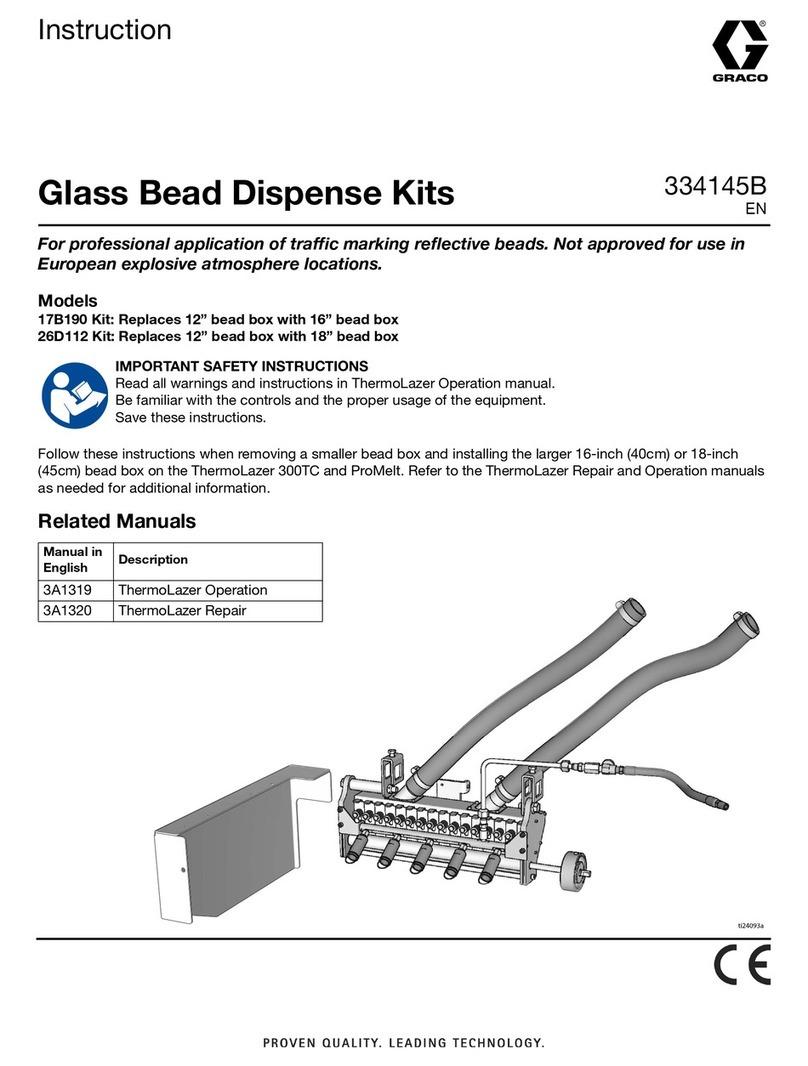
Graco
Graco 17B190 instructions
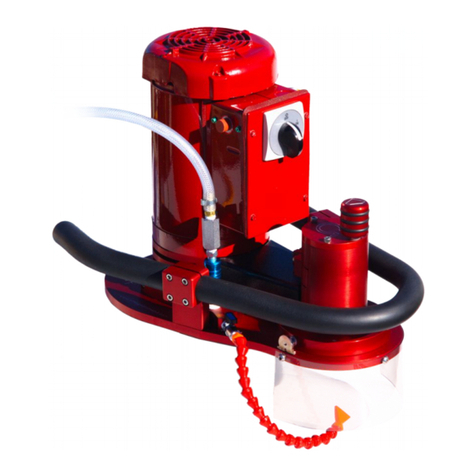
Omega Diamond
Omega Diamond The Red Ripper Operation, Safety, and Instruction Manual
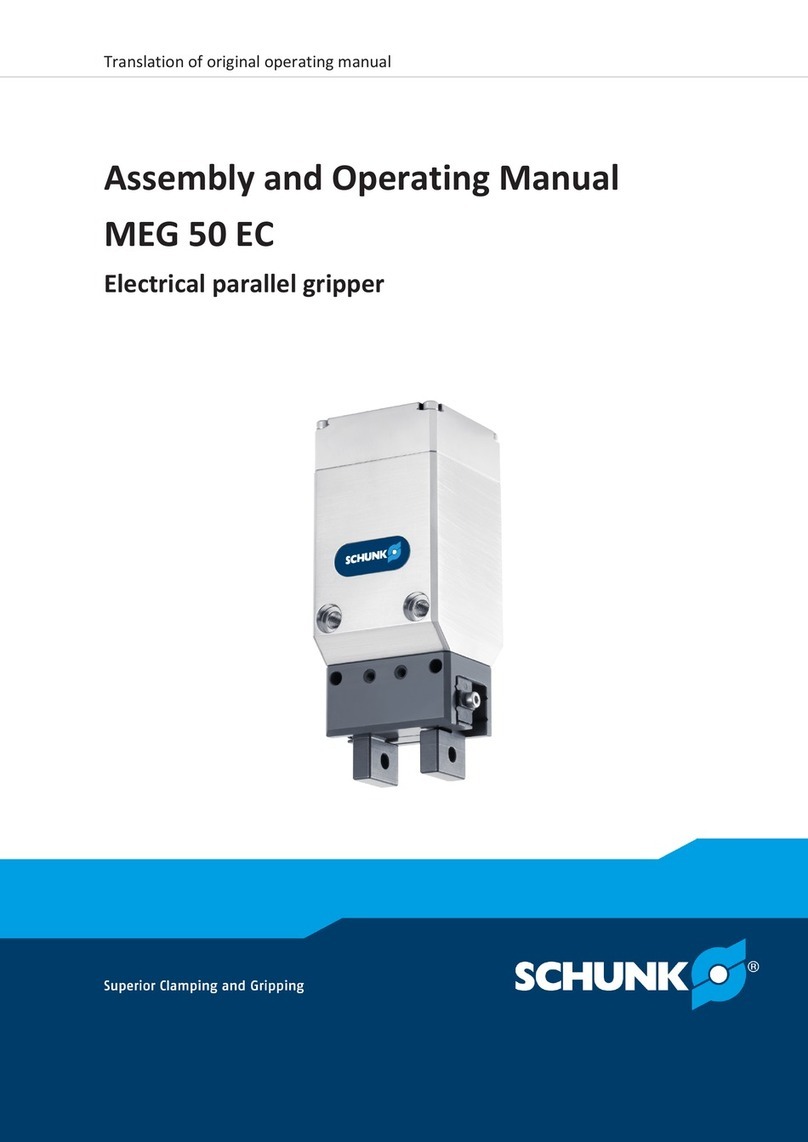
SCHUNK
SCHUNK MEG 50 EC Assembly and operating manual
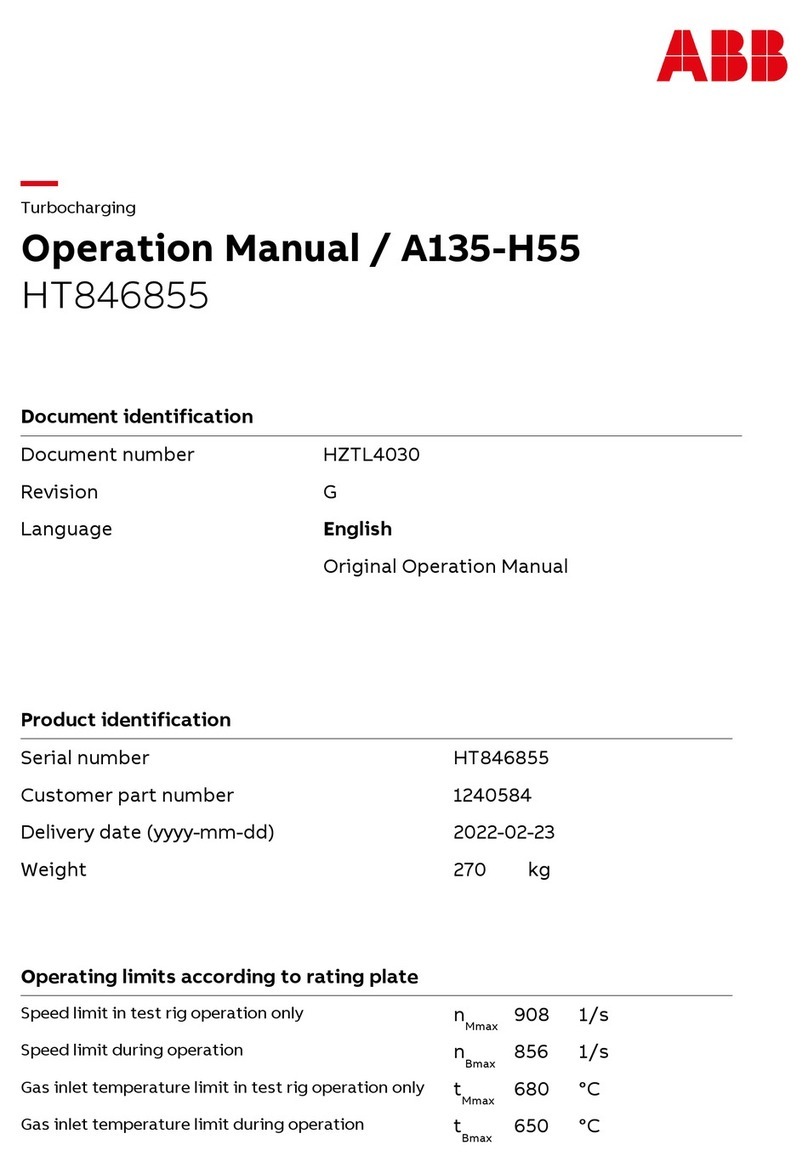
ABB
ABB HT846855 Operation manual

PCB Piezotronics
PCB Piezotronics 477A07 Installation and operating manual
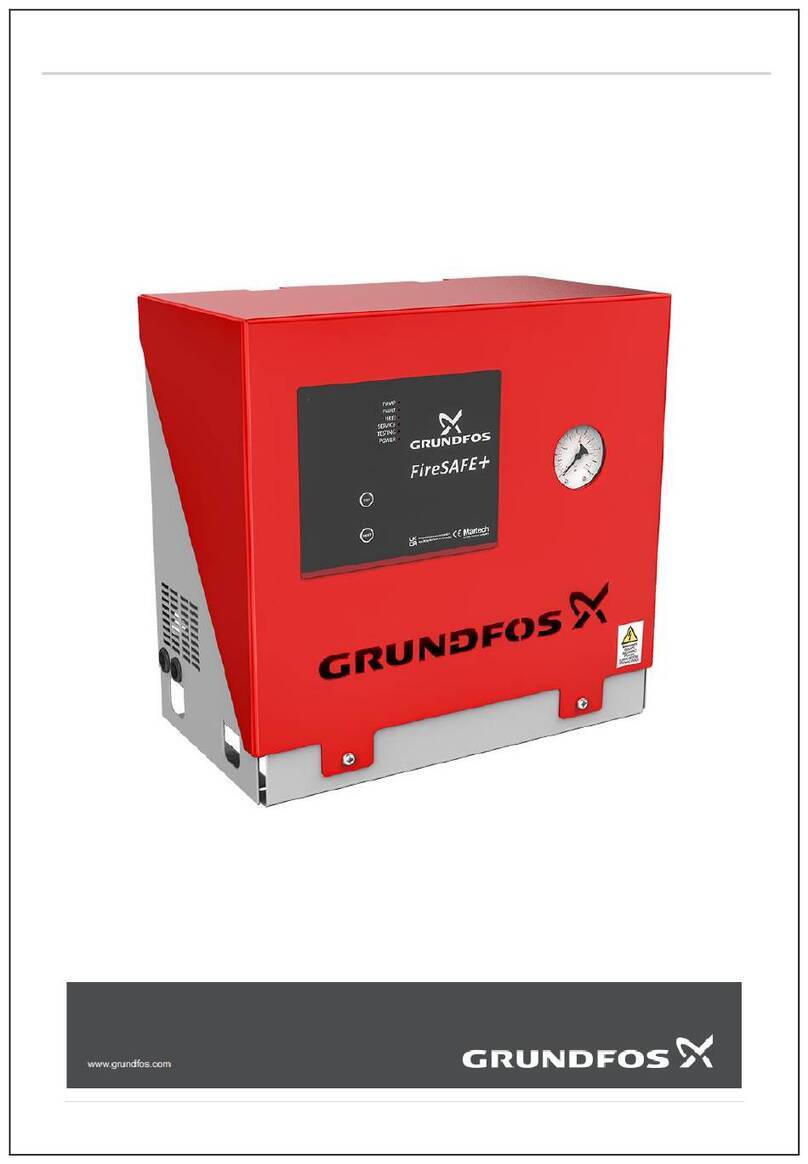
Grundfos
Grundfos FireSAFE+ instructions


